|
|
|
Sort Order |
|
|
|
Items / Page
|
|
|
|
|
|
|
| Srl | Item |
| 1 |
ID:
098614


|
|
|
|
|
| Publication |
2010.
|
| Summary/Abstract |
The Energy Independence and Security Act (EISA) of 2007 requires life-cycle assessment (LCA) for quantifying greenhouse gas emissions (GHGs) from expanded U.S. biofuel production. To qualify under the Renewable Fuel Standard, cellulosic ethanol and new corn ethanol must demonstrate 60% and 20% lower emissions than petroleum fuels, respectively. A combined corn-grain and corn-stover ethanol system could potentially satisfy a major portion of renewable fuel production goals. This work examines multiple LCA allocation procedures for a hypothetical system producing ethanol from both corn grain and corn stover. Allocation choice is known to strongly influence GHG emission results for corn-ethanol. Stover-derived ethanol production further complicates allocation practices because additional products result from the same corn production system. This study measures the carbon intensity of ethanol fuels against EISA limits using multiple allocation approaches. Allocation decisions are shown to be paramount. Under varying approaches, carbon intensity for corn ethanol was 36-79% that of gasoline, while carbon intensity for stover-derived ethanol was -10% to 44% that of gasoline. Producing corn-stover ethanol dramatically reduced carbon intensity for corn-grain ethanol, because substantially more ethanol is produced with only minor increases in emissions. Regulatory considerations for applying LCA are discussed.
|
|
|
|
|
|
|
|
|
|
|
|
|
|
|
|
| 2 |
ID:
088021


|
|
|
|
|
| Publication |
2009.
|
| Summary/Abstract |
Recently a number of objections have been raised against the use of ethanol produced from agricultural products such as maize, sugarcane, wheat or sugar beets as a replacement for gasoline, despite some of their advantages such as being cleaner and to some extent renewable. We address these objections in this paper. Topics discussed include the "corn connection" (which was theorized to be a cause of deforestation in the Amazonia), the rise of food prices due to ethanol production and the real possibilities of ethanol in reducing greenhouse gas emissions. It has been shown that such concerns are grossly exaggerated and that ethanol from sugarcane, as produced in Brazil, is the preferred option for the production of fuel not only in terms of cost but also as a favourable energy balance. Finally, the possibility of expanding ethanol production to other sugar-producing countries is also discussed.
|
|
|
|
|
|
|
|
|
|
|
|
|
|
|
|
| 3 |
ID:
103329


|
|
|
|
|
| Publication |
2011.
|
| Summary/Abstract |
The promotion and use of renewable energy sources are established priorities worldwide as a way to reduce emissions of Greenhouse Gases and promote energy security. Australia is committed to reach a target of 350 ML of biofuels per year by 2010, and incentives targeted to producers and consumers have been placed. These incentives include zero excise until 2011 for the ethanol produced in Australia and gradual increase of the taxation rates reaching the full excise of 0.125 AUD per litre by 2015. This paper analyses the viability of the second generation ethanol industry in the Green Triangle, one of the most promising Australian regions for biomass production, by comparing the energy adjusted pump prices of petrol and the produced ethanol under different taxation rates and forecasted oil prices. Major findings suggest that under the current conditions of zero fuel excise and oil prices around 80US$ per barrel ethanol production is viable using biomass with a plant gate cost of up to 74 AUD per ton. Moreover, the forecasted increase in oil prices have a higher impact on the price of petrol than the increased ethanol excise on the pump price of the biofuel. Thus, by 2016 feedstock with a plant gate cost of up to 190 AUD per ton might be used for ethanol production, representing a flow of 1.7 million tons of biomass per year potentially mitigating 1.2 million tons of CO2 by replacing fossil fuels with ethanol.
|
|
|
|
|
|
|
|
|
|
|
|
|
|
|
|
| 4 |
ID:
166352
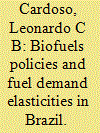

|
|
|
|
|
| Summary/Abstract |
Biofuels are often seen by policymakers as solutions to concerns about the environment, energy diversification, and rural development. To understand the impacts of biofuel policy, however, it is important to understand demand elasticities. Brazil, a leader in biofuels, provides a unique setting to increase our knowledge about biofuel policy and the interactions within and between the gasoline and ethanol markets. We estimate own-price, cross-price, and income elasticities of the demand for ethanol and gasoline using a novel instrumental variable approach to control for the inherent endogeneity between supply and demand. This results in own-price elasticities for both fuels higher than previous literature suggests: approximately − 0.9 for gasoline and − 1.5 for ethanol. Income elasticities for both fuels are approximately 0.8. We also examine the elasticity impacts following the introduction of flex-fuel cars into the Brazilian market. By estimating the model with over 100 subsamples across time, we find that cross-price elasticities become positive, significant, and increasing, but only after larger market penetration of flex-fuel cars, which occurred approximately three years after their introduction.
|
|
|
|
|
|
|
|
|
|
|
|
|
|
|
|
| 5 |
ID:
096709
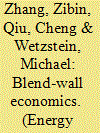

|
|
|
|
|
| Publication |
2010.
|
| Summary/Abstract |
The US Environmental Protection Agency is currently considering a waiver allowing an increase in the fuel-ethanol blend limit (the "blend wall") from 10% (E10) up to 15% (E15). Justifications for this waiver are reduced vehicle fuel prices and less consumption of petroleum gasoline leading to energy security. A theoretical examination of this waiver reveals an anomaly where a relaxation of this blend wall elicits a demand response. Under a wide range of elasticities, this demand response can actually increase the consumption of petroleum gasoline and thus lead to greater energy insecurity. The economics supporting this result and associated policy implications are developed and discussed.
|
|
|
|
|
|
|
|
|
|
|
|
|
|
|
|
| 6 |
ID:
097496
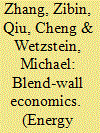

|
|
|
|
|
| Publication |
2010.
|
| Summary/Abstract |
The US Environmental Protection Agency is currently considering a waiver allowing an increase in the fuel-ethanol blend limit (the "blend wall") from 10% (E10) up to 15% (E15). Justifications for this waiver are reduced vehicle fuel prices and less consumption of petroleum gasoline leading to energy security. A theoretical examination of this waiver reveals an anomaly where a relaxation of this blend wall elicits a demand response. Under a wide range of elasticities, this demand response can actually increase the consumption of petroleum gasoline and thus lead to greater energy insecurity. The economics supporting this result and associated policy implications are developed and discussed.
|
|
|
|
|
|
|
|
|
|
|
|
|
|
|
|
| 7 |
ID:
101388


|
|
|
|
|
| Publication |
2011.
|
| Summary/Abstract |
Ethanol has recently been of great interest worldwide because it is a viable economic alternative to petroleum products and it is a renewable source of energy that mitigates the emission of greenhouse gases. Brazilian bioethanol from sugarcane is the most successful case at the world level because of its low cost and low level of greenhouse gas emissions. Brazil's success with sugarcane cannot be understood as based solely on a natural comparative advantage, but as a result of efforts that culminated in a positive trajectory of technological learning, relying mostly on incremental innovations. The purpose of this article is to analyze the key aspects of the innovation system built around the Brazilian sugarcane industry. It is based on the national innovation systems approach according to which innovation results from the interaction of different institutional actors. Institutional arrangements are analyzed as the basis for the innovative process, in particular R&D and the innovation policies and strategies of the main players in the sugarcane sector, including sugar and ethanol mills, industrial goods suppliers, public and private research institutions, and governmental agencies.
|
|
|
|
|
|
|
|
|
|
|
|
|
|
|
|
| 8 |
ID:
166984
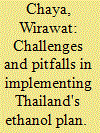

|
|
|
|
|
| Summary/Abstract |
Thailand's ethanol policy is embedded in the Alternative Energy and Development Plan 2015 (AEDP 2015). The policy goal is to increase ethanol production and consumption in 2036 at 223% of the baseline in 2015. A large demand for feedstock supplies, mainly molasses and cassava to meet the policy target causes concerns over their sufficiency. However, oversupply of ethanol has been observed occasionally. Since ethanol production and consumption are relevant to a number of policies, incoherence and gaps may contribute to the shortcomings. By applying a combined coherence and gap analysis, it is shown that crop zoning is irrelevant to and ineffective in securing the supply of ethanol. On the other hand, demand saturation is primarily due to the ineffectiveness of the state mechanisms. Key factors contributing to the problem are low prices of crude oil, high prices of feedstocks, managing availability of and accessibility to certain types of blended fuels in favor of the low blended ones, incorrect understanding of consumers towards high blended fuels and the public's recent interest towards electric vehicles. Political factors may also account for the slow-growing demand. The developed method is proved to be useful in determining effectiveness of interrelated policies dealing with ethanol.
|
|
|
|
|
|
|
|
|
|
|
|
|
|
|
|
| 9 |
ID:
023656
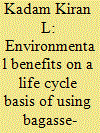

|
|
|
|
|
| Publication |
April 2002.
|
| Description |
371-384
|
|
|
|
|
|
|
|
|
|
|
|
|
|
|
|
| 10 |
ID:
127161


|
|
|
|
|
| Publication |
2014.
|
| Summary/Abstract |
This work compares the return on investments (ROI) of oil versus biofuels in Brazil. Although several renewable energy sources might displace oil, the country's forte is sugarcane biofuels. In our analysis we carry out simplified benefit-cost analyses of producing oil fields, pre-salt oil fields (without and with enhanced oil recovery), a business as the usual ethanol scenario, and a high ethanol scenario. Excluding the ROI from existing oil fields, which is the highest, when the discount rate is 4% or more, the ROI of the high ethanol scenario is greater than that of the ROI of pre-salt oil. Considering a US$40/t CO2 tax, the high ethanol scenario's ROI is greater than the pre-salt oil's ROI if a discount rate of 2% or more is adopted. Moreover, the high ethanol scenario throughput up to 2070 compares to 97% of the pre-salt oil reserve without EOR, and demands 78% of its investment. Pre-salt oil production declines beyond 2042 when the country might become a net oil importer. In contrast, ethanol production reaches 2.1 million boe per day, and another 0.9 million boe of fossil demand is displaced through bioelectricity, yielding a total of 3 million boe (62% of the country's oil demand).
|
|
|
|
|
|
|
|
|
|
|
|
|
|
|
|
| 11 |
ID:
076838
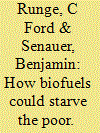

|
|
|
|
|
| Publication |
2007.
|
| Summary/Abstract |
Thanks to high oil prices and hefty subsidies, corn-based ethanol is now all the rage in the United States. But it takes so much supply to keep ethanol production going that the price of corn -- and those of other food staples -- is shooting up around the world. To stop this trend, and prevent even more people from going hungry, Washington must conserve more and diversify ethanol's production inputs
|
|
|
|
|
|
|
|
|
|
|
|
|
|
|
|
| 12 |
ID:
094920
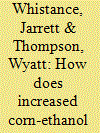

|
|
|
|
|
| Publication |
2010.
|
| Summary/Abstract |
In recent years, there has been a push to increase biofuel production in the United States. The biofuel of choice, so far, has been ethanol produced from corn. The effects of increased corn-ethanol production on the consumer prices of food and energy continue to be studied and debated. This study examines, in particular, the effects of increased corn-ethanol production on US natural gas prices. A structural model of the natural gas market is developed and estimated using two stage least squares. A baseline projection for the period 2007-2018 is determined, and two scenarios are simulated. In the first scenario, current biofuel policies including EISA mandates, tariffs, and tax credits are removed. In the second scenario, we hold ethanol production to the level required only for largely obligatory additive use. The results indicate that the increased level of corn-ethanol production occurring as a result of the current US biofuel policies may lead to natural gas prices that are as much as 0.25% higher, on average, than if no biofuel policies were in place. A similar comparison between the baseline and second scenario indicates natural gas prices could be as much as 0.5% higher, on average, for the same period.
|
|
|
|
|
|
|
|
|
|
|
|
|
|
|
|
| 13 |
ID:
092746


|
|
|
|
|
| Publication |
2009.
|
| Summary/Abstract |
The sustainability of biofuels, including the greenhouse gas (GHG) reduction that they achieve, is getting increased attention. Life cycle analyses (LCAs) of biofuels production routes show that the GHG savings may vary significantly for different biofuels. An increasing number of governments are therefore looking for options to differentiate between biofuels according to their actual GHG savings. Accurate calculations of GHG savings thus become increasingly important. This paper deals with an omission of current LCAs for ethanol and ETBE blends, which leads to an underestimation of their calculated GHG savings. Current studies do not take into account that refiners will adjust their refinery operation when bioethanol or ETBE is added, because of the different characteristics of these products. The analysis indicates that the net effect of these refinery modifications on the GHG savings is positive, i.e. GHG-emissions reduce in both cases. The emission reduction is highest in the case of ETBE. We recommend to include this effect in future LCA calculations for ethanol and ETBE. As the calculation model used for this study is only a simplified representation of the EU refinery sector, we also advise to perform a more detailed analysis of these effects using more elaborate refinery models.
|
|
|
|
|
|
|
|
|
|
|
|
|
|
|
|
| 14 |
ID:
092761


|
|
|
|
|
| Publication |
2009.
|
| Summary/Abstract |
The need for biofuels, particularly liquid ones like ethanol and biodiesel, for transport has been felt by most of the countries and their governments have been trying to promote these fuels. Compared to petroleum, the use of biofuels for transport is still quite low in nearly every country. By far the largest production and use is of ethanol in the United States and Brazil, where similar volumes are used-many times higher than in any other country. Even then, ethanol represents less than 3% of transport fuel in USA and a little more than 50% of gasoline demand (by volume) in Brazil. However many countries, including the USA, Canada, several European countries (and the European Union), Australia and Japan including India are considering or have adopted a variety of policies that could result in much higher biofuels use over the next decade. This paper makes an attempt to draw upon the cross-country international experiences of ethanol as transport fuel to suggest policy implications for India.
|
|
|
|
|
|
|
|
|
|
|
|
|
|
|
|
| 15 |
ID:
125421


|
|
|
|
|
| Publication |
2013.
|
| Summary/Abstract |
Just as temperate region pulp and paper companies need to compete with Brazilian eucalyptus pulp producers, lignocellulosic biofuel producers in North America and Europe, in the absence of protectionist trade policies, will need to be competitive with tropical and sub-tropical biofuel producers. This work sought to determine the impact of lignocellulosic ethanol biorefinery siting on economic performance and minimum ethanol selling price (MESP) for both east and west coast North American fuel markets. Facility sites included the pine-dominated Pacific Northwest Interior, the mixed deciduous forest of Ontario and New York, and the Brazilian state of Espírito Santo. Feedstock scenarios included both plantation (poplar, willow, and eucalyptus, respectively) and managed forest harvest. Site specific variables in the techno-economic model included delivered feedstock cost, ethanol delivery cost, cost of capital, construction cost, labour cost, electricity revenues (and co-product credits), and taxes, insurance, and permits. Despite the long shipping distance from Brazil to North American east and west coast markets, the MESP for Brazilian-produced eucalyptus lignocellulosic ethanol, modelled at $0.74 L-1, was notably lower than that of all North American-produced cases at $0.83-1.02 L-1.
|
|
|
|
|
|
|
|
|
|
|
|
|
|
|
|
| 16 |
ID:
132638


|
|
|
|
|
| Publication |
2014.
|
| Summary/Abstract |
The 2013 renewable energy policy mandates adopted in twenty-seven countries will increase the need for liquid biofuels. To achieve this, ethanol produced from corn and sugarcane will need to increase from 80 to approximately 200 billion l in 2021. This could be achieved by increasing the productivity of raw material per hectare, expansion of land into dedicated biofuels, or a combination of both. We show here that appropriate land expansion policies focused on conservationist programs and a scientific basis, are important for sustainable biofuel expansion whilst meeting the increasing demand for food and fiber. The Brazilian approach to biofuel and food security could be followed by other nations to provide a sustainable pathway to renewable energy and food production globally.
|
|
|
|
|
|
|
|
|
|
|
|
|
|
|
|
| 17 |
ID:
096099
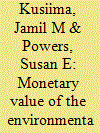

|
|
|
|
|
| Publication |
2010.
|
| Summary/Abstract |
This research is aimed at monetizing the life cycle environmental and health externalities associated with production of ethanol from corn, corn stover, switchgrass, and forest residue. The results of this study reveal current average external costs for the production of 1 l of ethanol ranged from $0.07 for forest residue to $0.57 for ethanol production from corn. Among the various feedstocks, the external costs of PM10, NOX, and PM2.5 are among the greatest contributors to these costs. The combustion of fossil fuels in upstream fertilizer and energy production processes is the primary source of these emissions and their costs, especially for corn ethanol. The combined costs of emissions associated with the production and use of nitrogen fertilizer also contribute substantially to the net external costs. For cellulosic ethanol production, the combustion of waste lignin to generate heat and power helps to keep the external costs lower than corn ethanol. Credits both for the biogenic carbon combustion and displacement of grid electricity by exporting excess electricity substantially negate many of the emissions and external costs. External costs associated with greenhouse gas emissions were not significant. However, adding estimates of indirect GHG emissions from land use changes would nearly double corn ethanol cost estimates.
|
|
|
|
|
|
|
|
|
|
|
|
|
|
|
|
| 18 |
ID:
177491
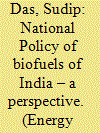

|
|
|
|
|
| Summary/Abstract |
The National Policy on Biofuels (NPB) 2018 was adopted on May 16, 2018 in India to augment the generation of biofuels and to build a sustainable biofuel ecosystem. The Biodiesel Blending programme (BBP) got affected due to lack of sufficient feedstock coupled with an 18% Goods and Services Tax (GST) effective from July 1, 2017. The high GST resulted in the price of biodiesel being higher than that of conventional diesel thereby hindering the blending mandates. Most states in India do not allow free interstate movement of molasses resulting in artificially depressed prices besides derailing the Ethanol Blending Petrol (EBP) programme. NPB 2018 prohibits the import and export of biofuels to other nations resulting in reduced economic efficiency. The use of foodgrains as feedstock for biofuel production hampers food availability to the needy people and adversely affects food prices. The higher funding and incentives proposed to 2G ethanol production in NPB 2018 needs to be extended to 1G ethanol also as majority of the ethanol production happens through 1G. The paper touches upon the key biofuel policies of various nations, features of NPB 2018 and its critical analysis, BBP and EBP programmes and their current challenges and suggests future reforms.
|
|
|
|
|
|
|
|
|
|
|
|
|
|
|
|
| 19 |
ID:
105736


|
|
|
|
|
| Publication |
2011.
|
| Summary/Abstract |
The use of ethanol as a fuel has been attracting increasing attention in countries that are interested in reducing their dependence on imported oil and lowering their greenhouse gas emissions. Despite this growing interest, the global ethanol market is still incipient because of the small number of producing countries, the lack of technical standardization and the existence of tariff and non-tariff trade barriers. New laws have taken effect in 2010 in the United States and the European Union imposing domestic requirements for sustainable production of ethanol. Although these are generally positive developments, they can create greater difficulties for the development of an international ethanol market. This work examines the technical barriers posed by these new laws and how they can be resolved under the auspices of the World Trade Organization. In addition, this work analyses the Brazilian and Caribbean cases discussing to what extent these new technical barriers will affect ethanol production and exports arising from these countries.
|
|
|
|
|
|
|
|
|
|
|
|
|
|
|
|
| 20 |
ID:
116963
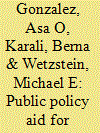

|
|
|
|
|
| Publication |
2012.
|
| Summary/Abstract |
Recent failures of renewable energy plants have raised concerns regarding government's role in providing credit subsidies and have harmed the long-run development of renewable energy. The major reason for these failures lies in government loan appraisers not having a model that addresses these root causes and instead relying on traditional net present value (NPV) analysis. What is required is a model representing entrepreneurs' investment decision processes when faced with uncertainty, irreversibility, and flexibility that characterize renewable energy investments. The aim is to develop such a model with a real options analysis (ROA) criterion as the foundation. A case study comparing NPV with ROA decisions for 50 and 100 million gallon ethanol plants is used as a basis for future development of a template government loan appraisers can use for evaluating the feasibility of renewable energy investments.
|
|
|
|
|
|
|
|
|
|
|
|
|
|
|
|
|
|
|
|
|